Chemical Characterisation of Construction and Demolition Waste in Skopje City and Its Surroundings (Republic of Macedonia)
Abstract
1. Introduction
2. Census of Dump Sites in the Skopje City and its Surroundings and C&D Waste Sampling
3. Analytical Methods
4. Results and Discussion
5. Conclusions
Supplementary Materials
Author Contributions
Funding
Acknowledgments
Conflicts of Interest
References
- Blengini, G.A.; Garbarino, E. Resources and waste management in Turin (Italy): The role of recycled aggregates in the sustainable mix. J. Clean. Prod. 2010, 18, 1021–1030. [Google Scholar] [CrossRef]
- De Melo, A.B.; Goncalves, A.F.; Martins, I.M. Construction and demolition waste generation and management in Lisbon (Portugal). Resour. Conserv. Recycl. 2011, 55, 1252–1264. [Google Scholar] [CrossRef]
- Mercedes, R.M.; Pilar, I.G.; Isabel, S.W.A. Sustainable construction: Construction and demolition waste reconsidered. Waste Manag. Res. 2009, 28, 118–129. [Google Scholar] [CrossRef]
- Borghi, G.; Pantini, S.; Rigamonti, L. Life cycle assessment of non-hazardous Construction and Demolition Waste (CDW) management in Lombardy Region (Italy). J. Clean. Prod. 2018, 184, 815–825. [Google Scholar] [CrossRef]
- Bianchini, G.; Marrocchino, E.; Tassinari, R.; Vaccaro, C. Recycling of construction and demolition waste materials: A chemical-mineralogical appraisal. Waste Manag. 2005, 25, 149–159. [Google Scholar] [CrossRef]
- European Parliament. Directive 2008/98/CE of the European Parliament and of the Council of 19 November 2008 on Waste and Repealing Certain Directives. Off. J. Eur. Union 2008, L312, 3–30. [Google Scholar]
- Christensen, T.H.; Birgisdottir, H. Recycling of construction and demolition waste. In Solid Waste Technology and Management, 1st ed.; Christensen, T.H., Ed.; Blackwell Publishing Ltd.: Oxford, UK, 2011; Volume 2, pp. 243–249. [Google Scholar]
- Ristovski, I.; Milcov, I.; Zupanc, A.; Bianchini, G.; Natali, C.; Salani, G.M. Methodology for C&D waste collection and disposal and associated greenhouse gas emissions: Experiences from project SAMCODE in Skopje planning region. In Proceedings of the 6th Edition of European Conference on Water, Waste and Energy Management, Stockholm, Sweden, 13–14 May 2019. [Google Scholar]
- Limbachiya, M.; Marrocchino, E.; Koulouris, A. Chemical-mineralogical characterisation of coarse recycled concrete aggregate. Waste Manag. 2007, 27, 201–208. [Google Scholar] [CrossRef]
- Dimovska, S.; Stafilov, T.; Sajn, R. Radioactivity in soil from the city of Kavadarci (Republic of Macedonia) and its environs. Radiat. Prot. Dosimetry 2012, 148, 107–120. [Google Scholar] [CrossRef]
- Stojanovska, Z.; Boev, B.; Bossew, P.; Ristova, M.; Dimov, G.; Boev, I.; Zunic, Z.S. Analysis of specific radionuclide activity variations in soil within geotectonic units of Republic of North Macedonia. Nuclear Technol. Radiat. Prot. 2019, 34, 85–93. [Google Scholar] [CrossRef]
- Natali, C.; Bianchini, G.; Carlino, P. Thermal stability of soil carbon pools: Inferences on soil nature and evolution. Thermochim. Acta 2020, 683, 178478. [Google Scholar] [CrossRef]
- Lachance, G.R.; Traill, R.J. Practical solution to the matrix problem in X-ray analysis. Can. J. Spectros. 1966, 11, 43–48. [Google Scholar]
- Kuzyakov, Y. Priming effects: Interactions between living and dead organic matter. Soil Biol. Biochem. 2010, 42, 1363–1371. [Google Scholar] [CrossRef]
- Manning, D.A.C. Introduction to industrial Minerals, 1st ed.; Springer Science+Business: London, UK, 1995; pp. 141–158. [Google Scholar] [CrossRef]
- Fiori, C.; Fabbri, B.; Donati, G.; Venturi, I. Mineralogical composition of the clay bodies used in the Italian tile industry. Appl. Clay Sci. 1989, 4, 461–473. [Google Scholar] [CrossRef]
- Bianchini, G.; Martucci, A.; Vaccaro, C. Petro-archaeometric characterisation of “cotto ferrarese”: Bricks and terracotta elements from historic buildings of Ferrara. Period. Mineral. 2002, 71, 101–111. [Google Scholar]
- Morais, S.; Garcia, F.; de Lourdes Pereira, C.M. Heavy metals and human health. In Environmental Health—Emerging Issues and Practice; Oosthuizen, J., Ed.; InTech: London, UK, 2012. [Google Scholar] [CrossRef]
- Prieto-Taboada, N.; Ibarrondo, I.; Gómez-Laserna, O.; Martinez-Arkarazo, I.; Olazabal, M.A.; Madariaga, J.M. Buildings as repositories of hazardous pollutants of anthropogenic origin. J. Hazard Mater. 2013, 248–249, 451–460. [Google Scholar] [CrossRef] [PubMed]
- Gao, X.; Gu, Y.; Xie, T.; Zhen, G.; Huang, S.; Zhao, Y. Characterization and environmental risk assessment of heavy metals in construction and demolition wastes from five sources (chemical, metallurgical and light industries, and residential and recycled aggregates). Environ. Sci. Pollut. Res. 2015, 22, 9332–9344. [Google Scholar] [CrossRef]
- Townsend, T.; Tolaymat, T.; Leo, K.; Jambeck, J. Heavy metals in recovered fines from construction and demolition debris recycling facilities in Florida. Sci. Total Environ. 2004, 332, 1–11. [Google Scholar] [CrossRef]
- The Government of Italy. Legislative Decree 152/06 (2006) Norme in materia ambientale; Official Gazette n. 88; The Government of Italy: Rome, Italy, 2006. (In Italian) [Google Scholar]
- CEPA (Chinese Environmental Protection Administration). Environmental Quality Standard for Soils (GB15618-1995); CEPA: Beijing, China, 1995. (In Chinese) [Google Scholar]
- ESdat. Dutch Soil Remediation Circular 2009; ESdat: Ballina, NSW, Australia, 2009; Available online: http://esdat.net/Environmental%20Standards/Dutch/ENGELSE%20versie%20circulaire%20Bodemsanering%202009.pdf (accessed on 15 January 2020).
- Augé, T.; Morin, G.; Bailly, L.; Serafimovsky, T. Platinum-group minerals and their host chromitites in Macedonian ophiolites. Eur. J. Mineral. 2017, 29, 585–596. [Google Scholar] [CrossRef]
- Božović, M.; Prelević, D.; Romer, R.L.; Barth, M.; Van Den Bogaard, P.; Boev, B. The Demir Kapija ophiolite, Macedonia (FYROM): A snapshot of subduction Initiation within a back-arc. J. Petrol. 2013, 54, 1427–1453. [Google Scholar] [CrossRef]
- Tasev, G.; Serafimovski, D.; Serafimovski, T. Evolution of ore-forming fluids in the Bukovik-Kadiica porphyry Cu deposit, Republic of Macedonia. Geologia Croatica 2018, 71, 1–18. [Google Scholar] [CrossRef]
- Mihajlov, M.; Barandovski, L.; Šajn, R.; Stafilov, T. Spatial distribution of heavy metals in soils in the Republic of Macedonia. Geologica Macedonica 2016, 30, 41–54. [Google Scholar]
- Puteska, A.; Dimovska1, B.; Šajn, R.; Stafilov, T. Distribution of chemical elements in soil samples from the Pelagonia region, Republic of Macedonia. Geologia Croatica 2015, 68, 261–272. [Google Scholar] [CrossRef][Green Version]
- Stafilov, T.; Šajn, R.; Ahmeti, L. Geochemical characteristics of soil of the city of Skopje, Republic of Macedonia. J. Environ. Sci. Health Part A 2019, 54, 972–987. [Google Scholar] [CrossRef] [PubMed]
- Karim, M.R.; Kuraoka, M.; Higuchi, T.; Sekine, M.; Imai, T. Assessment of heavy metal contamination from municipal solid waste open dumping sites in Bangladesh. J. Hydrol. Environ. Res. 2014, 2, 41–49. [Google Scholar] [CrossRef]
- Scott, J.; Beydown, D.; Amal, R.; Low, G.; Cattle, J. Landfill management, leachate generation and leach testing of solid wastes in Australia and overseas. Crit. Rev. Environ. Sci. 2005, 35, 239–332. [Google Scholar] [CrossRef]
- Ente Nazionale Italiano di Unificazione. UNI EN 12457—Part 2 (2004)—Characterisation of Waste-Leaching-Compliance Test for Leaching of Granular Waste Materials and Sludges—Part 2: One Stage Batch Test at a Liquid to Solid Ratio of 10 l/kg for Materials with Particle Size below 4 mm (without or with Size Reduction); Ente Nazionale Italiano di Unificazione: Milan, Italy, 2004. [Google Scholar]
- The Government of Italy. Ministerial Decree n. 186 (2006) Regolamento Recante Modifiche al Decreto Ministeriale 5 Febbraio 1998 “Individuazione dei Rifiuti non Pericolosi Sottoposti alle Procedure Semplificate di Recupero, ai Sensi Degli Articoli 31 e 33 del Decreto Legislativo 5 Febbraio 1997, n. 22” (Regulatory that Modified Ministerial Decree Dated 5 February 1998); Official Gazette no. 115; The Government of Italy: Rome, Italy, 2006. (In Italian) [Google Scholar]
- The Government of Italy. Ministerial Decree (1998) Individuazione dei Rifiuti non Pericolosi Sottoposti alle Procedure Semplificate di Recupero ai Sensi Degli Articoli 31 e 33 del D.Lgs 5 Febbraio 1997, n.22 (Identification of Non-Hazardous Waste Subject to Simplified Recovery Procedures under Articles 31 and 33 of Legislative Decree 5 February 1997 n. 22); Official Gazette no. 88; The Government of Italy: Rome, Italy, 1998. (In Italian) [Google Scholar]
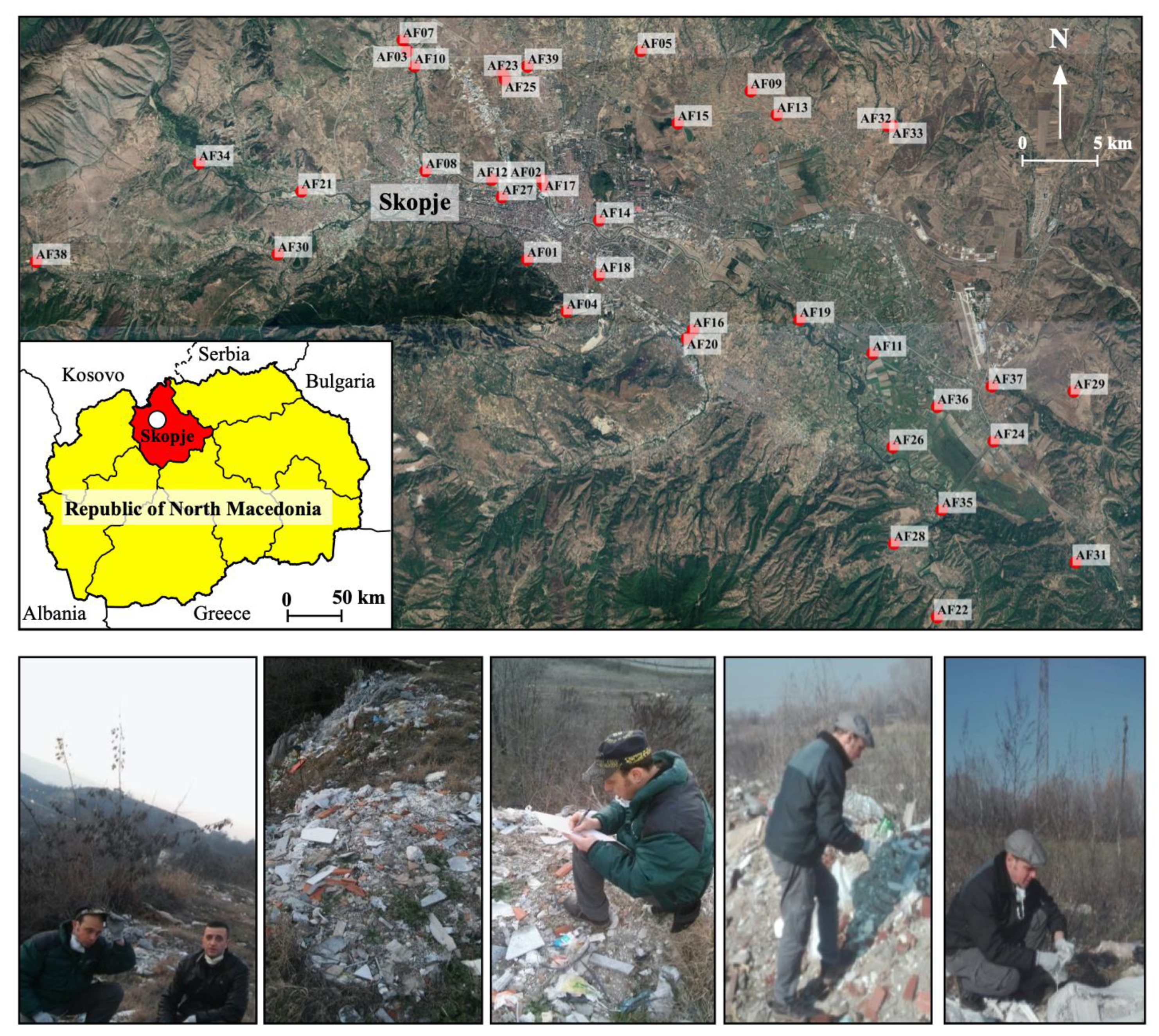
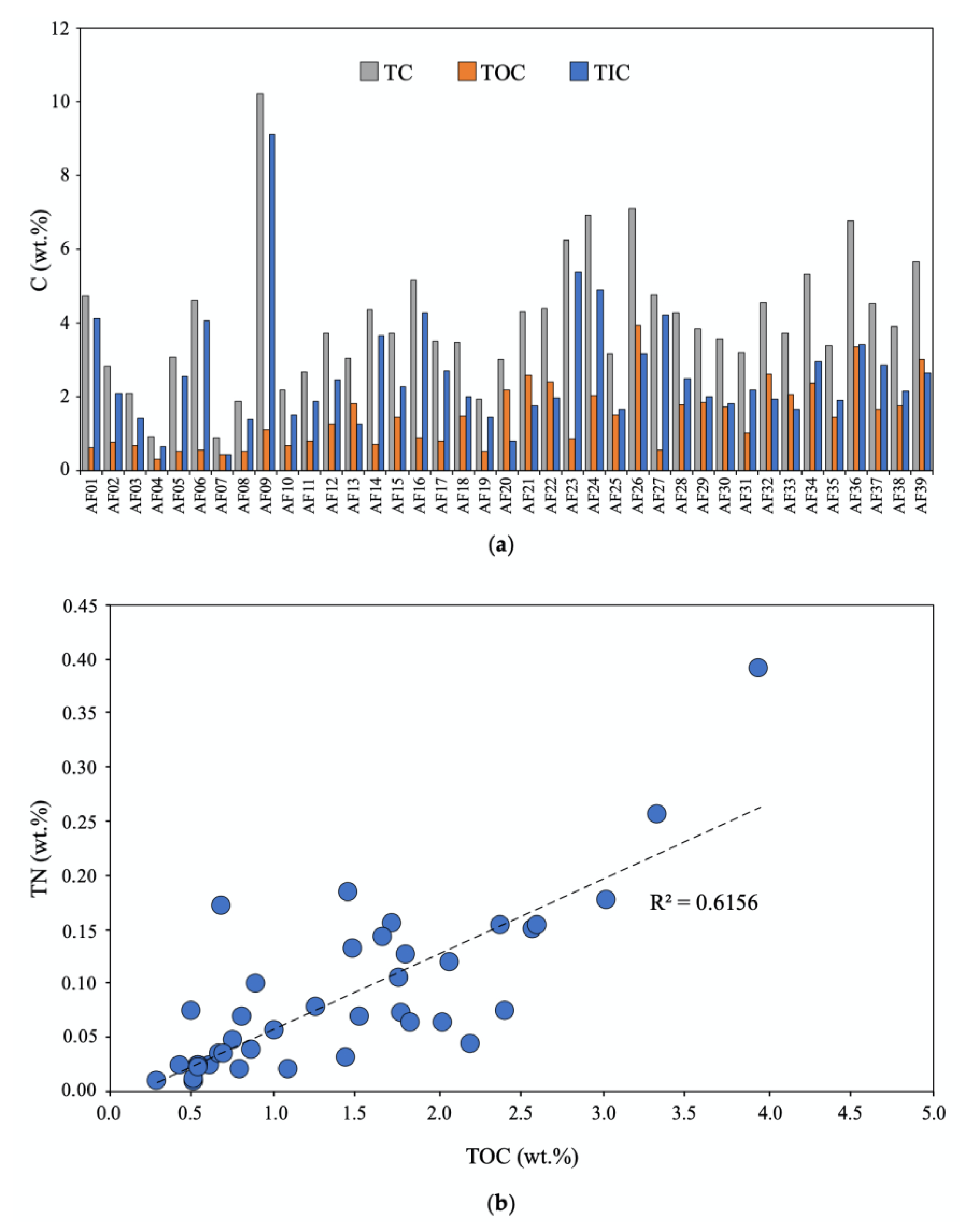
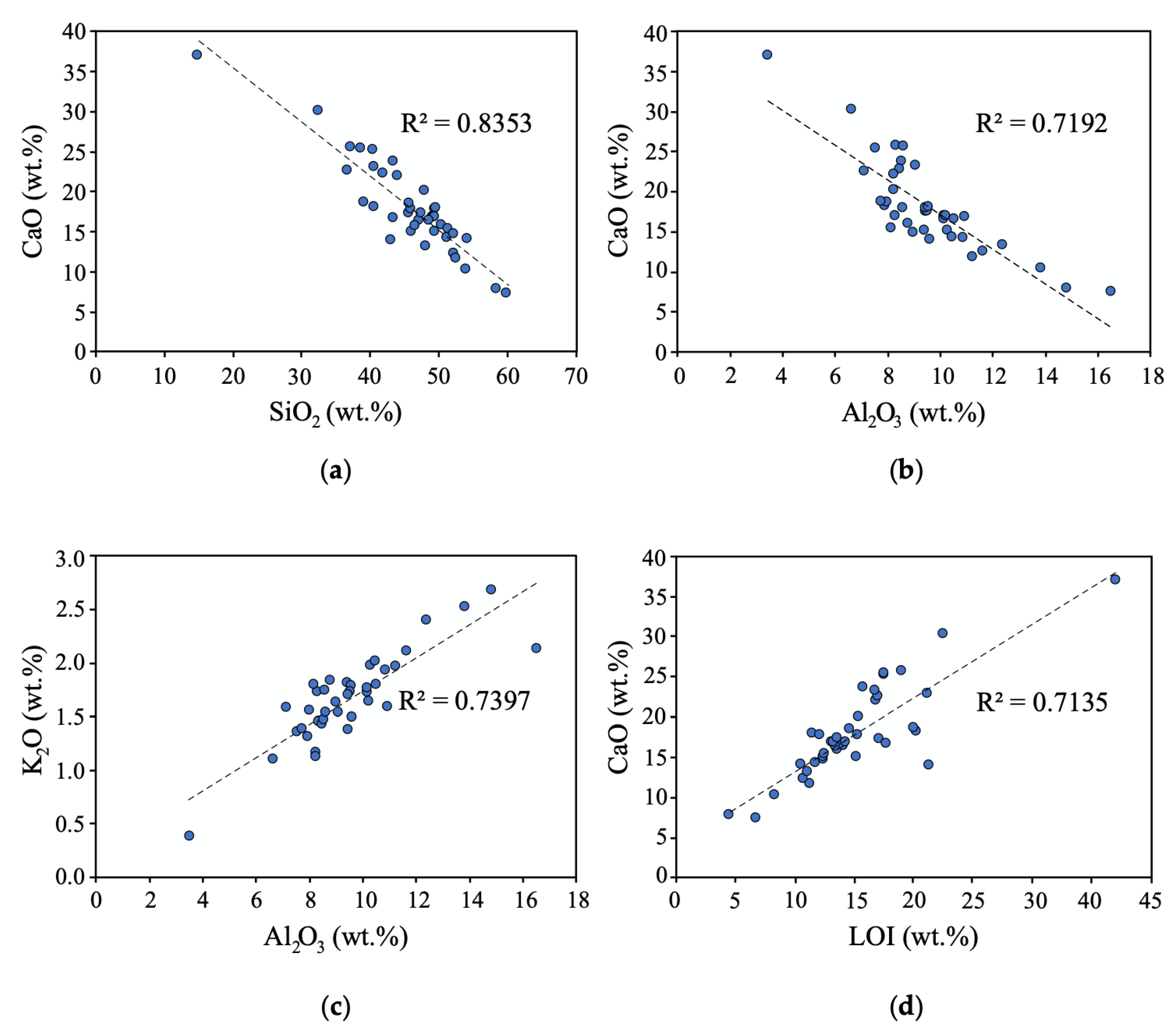
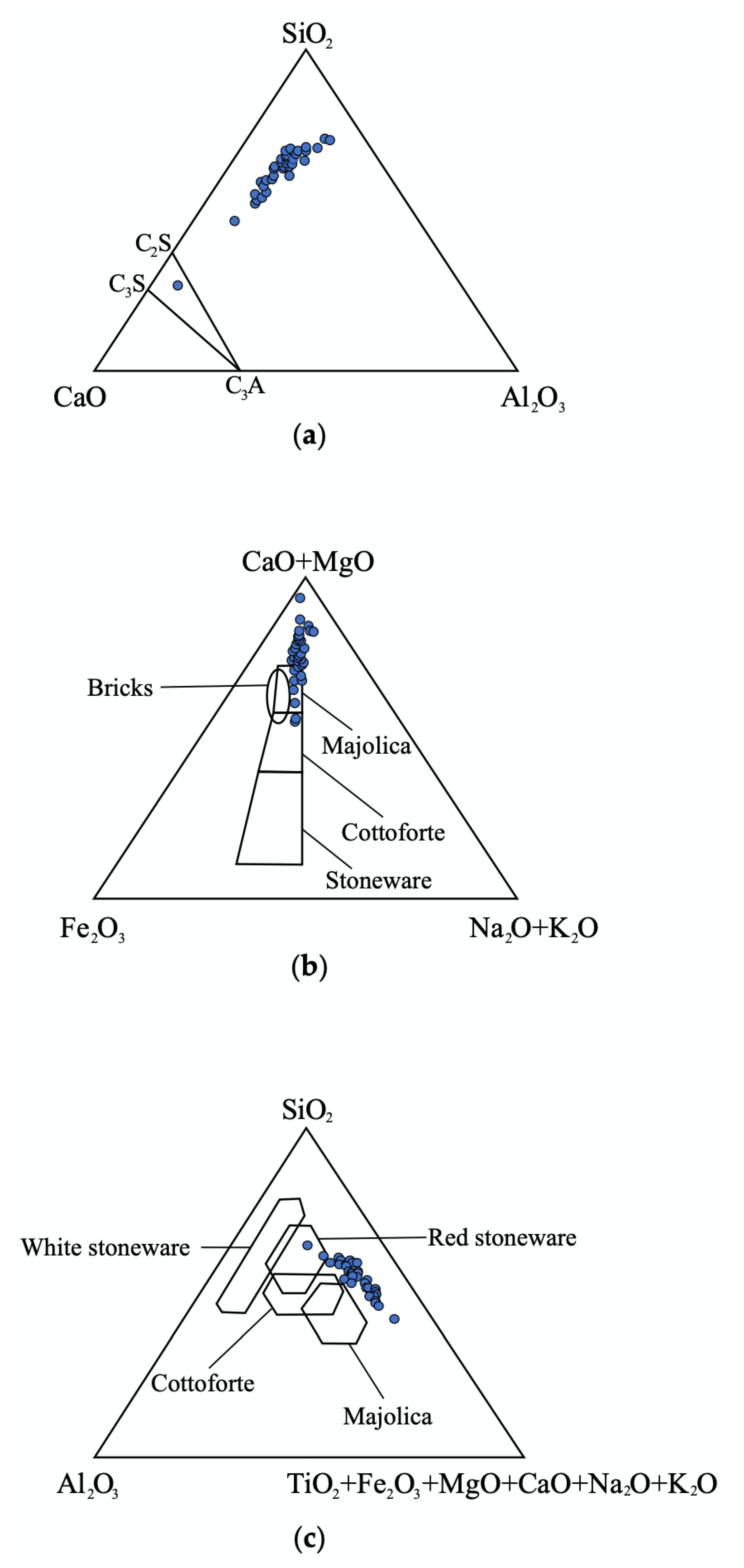
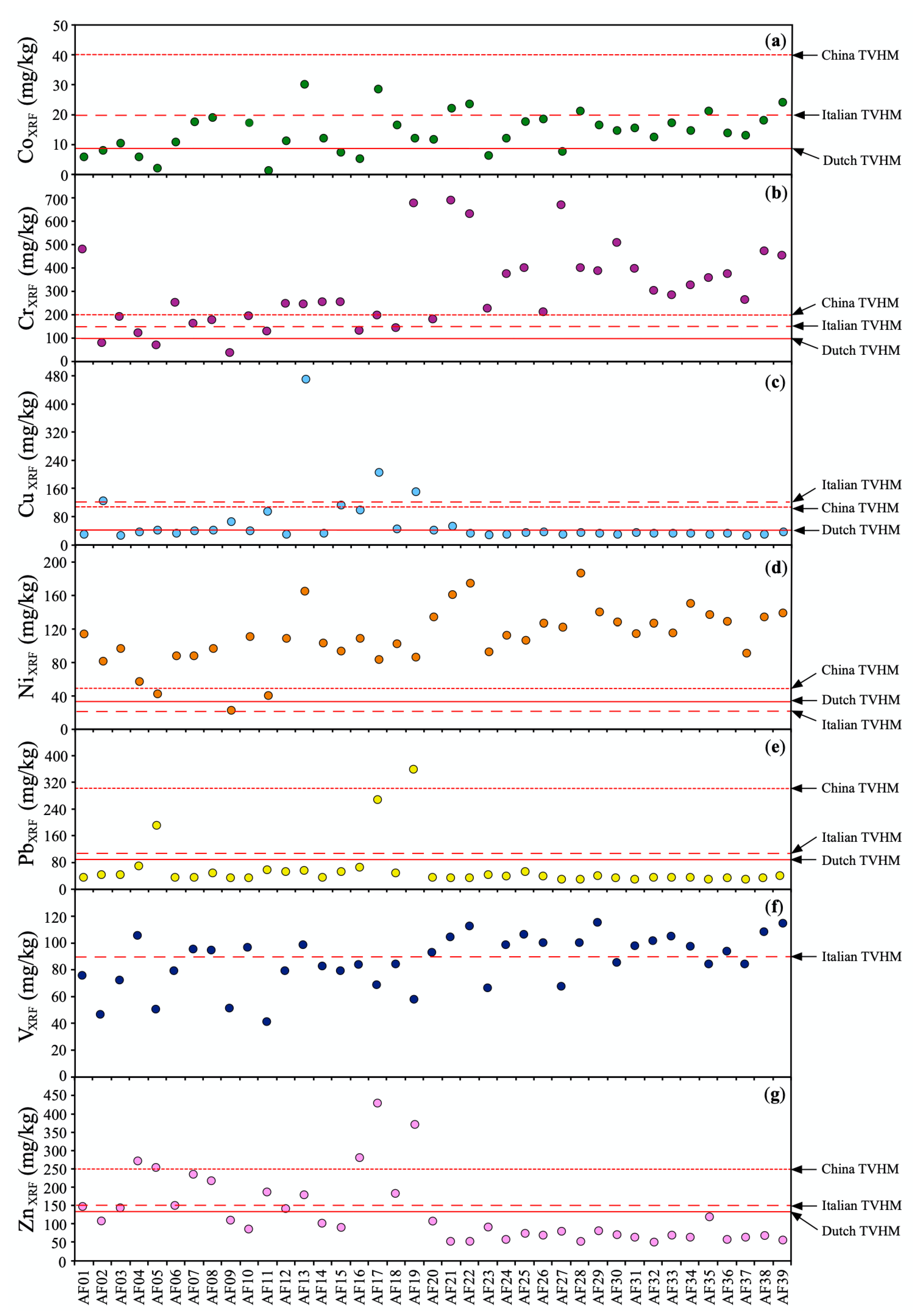
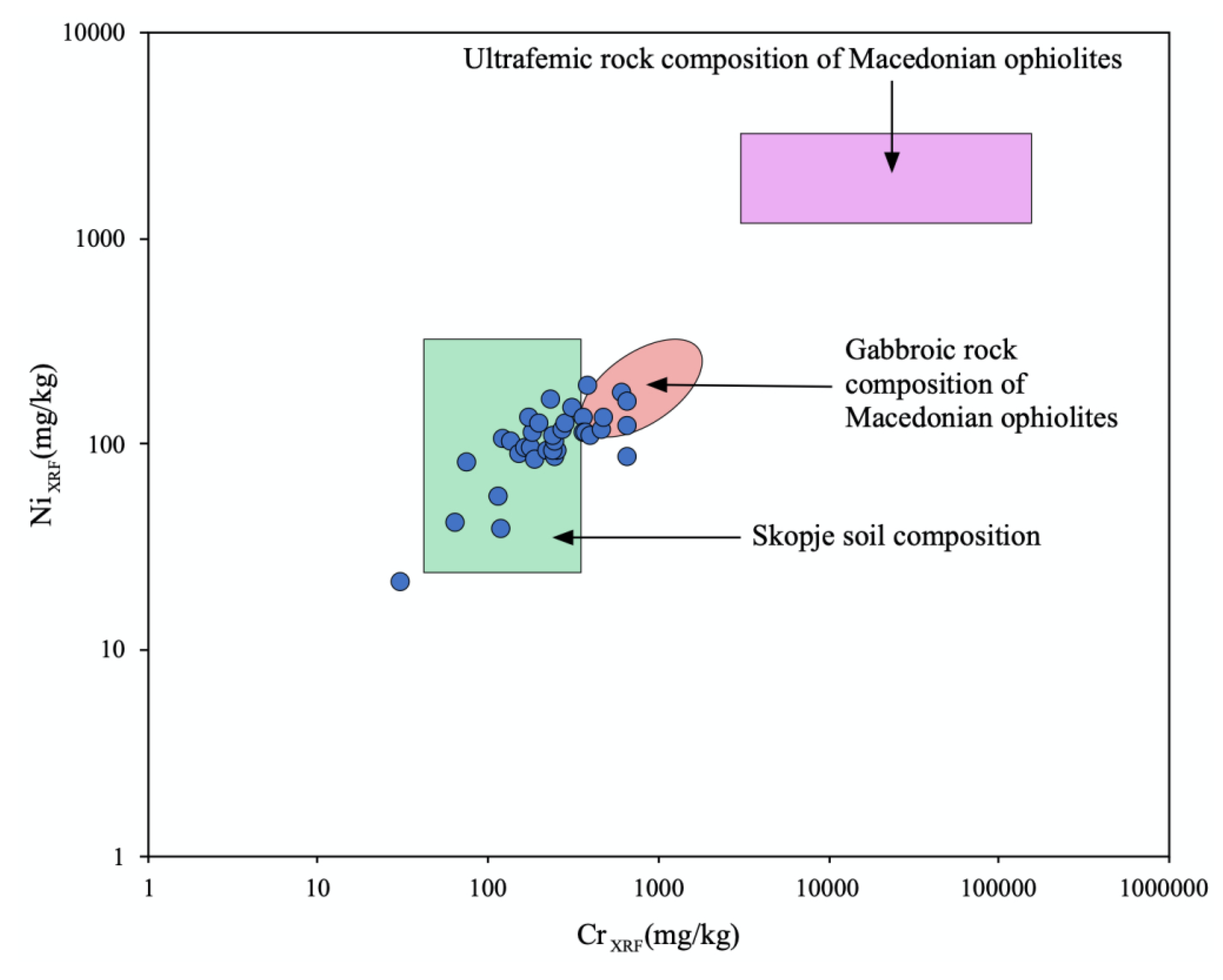
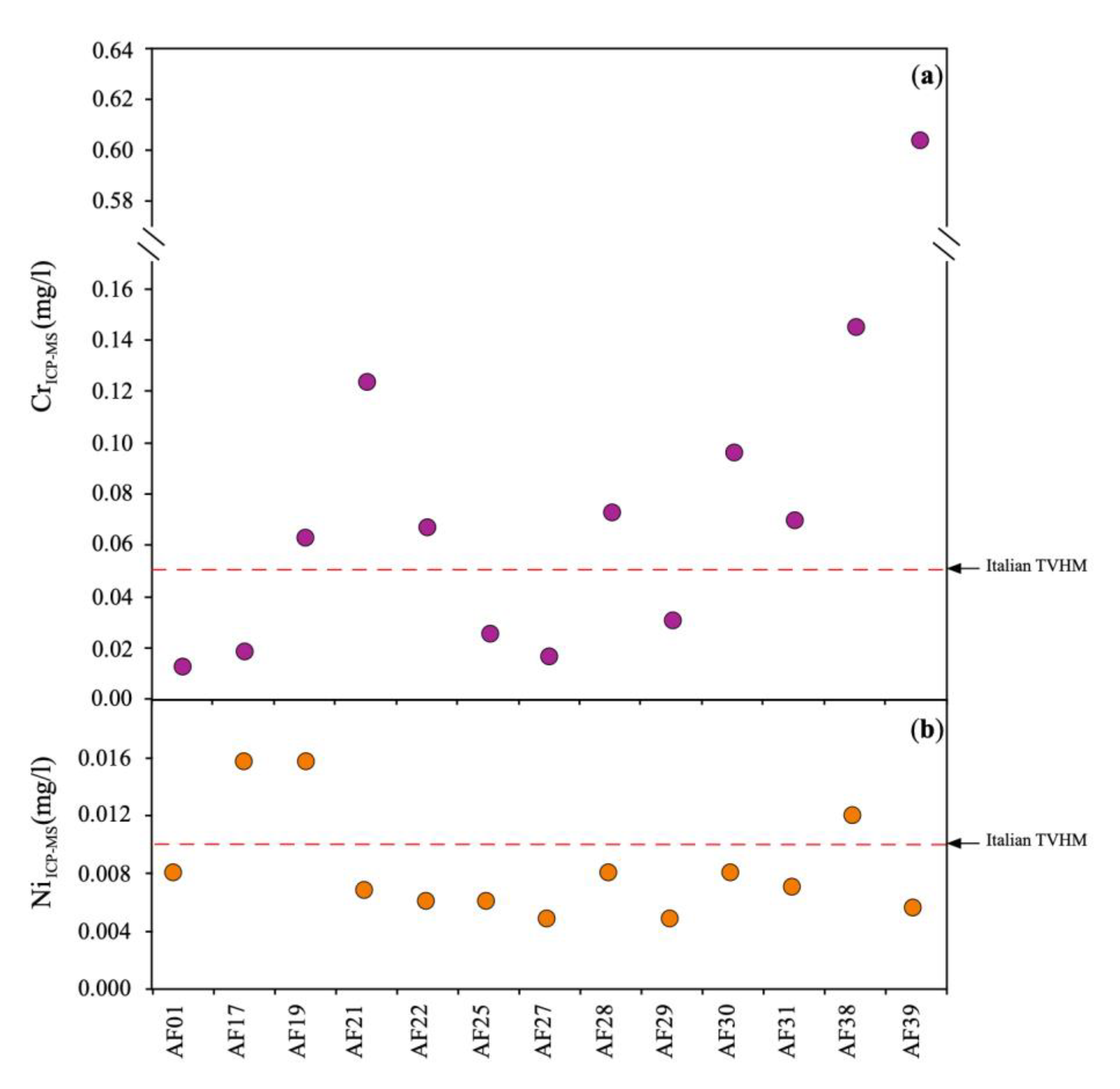
© 2020 by the authors. Licensee MDPI, Basel, Switzerland. This article is an open access article distributed under the terms and conditions of the Creative Commons Attribution (CC BY) license (http://creativecommons.org/licenses/by/4.0/).
Share and Cite
Bianchini, G.; Ristovski, I.; Milcov, I.; Zupac, A.; Natali, C.; Salani, G.M.; Marchina, C.; Brombin, V.; Ferraboschi, A. Chemical Characterisation of Construction and Demolition Waste in Skopje City and Its Surroundings (Republic of Macedonia). Sustainability 2020, 12, 2055. https://doi.org/10.3390/su12052055
Bianchini G, Ristovski I, Milcov I, Zupac A, Natali C, Salani GM, Marchina C, Brombin V, Ferraboschi A. Chemical Characterisation of Construction and Demolition Waste in Skopje City and Its Surroundings (Republic of Macedonia). Sustainability. 2020; 12(5):2055. https://doi.org/10.3390/su12052055
Chicago/Turabian StyleBianchini, Gianluca, Igor Ristovski, Igor Milcov, Alojz Zupac, Claudio Natali, Gian Marco Salani, Chiara Marchina, Valentina Brombin, and Andrea Ferraboschi. 2020. "Chemical Characterisation of Construction and Demolition Waste in Skopje City and Its Surroundings (Republic of Macedonia)" Sustainability 12, no. 5: 2055. https://doi.org/10.3390/su12052055
APA StyleBianchini, G., Ristovski, I., Milcov, I., Zupac, A., Natali, C., Salani, G. M., Marchina, C., Brombin, V., & Ferraboschi, A. (2020). Chemical Characterisation of Construction and Demolition Waste in Skopje City and Its Surroundings (Republic of Macedonia). Sustainability, 12(5), 2055. https://doi.org/10.3390/su12052055








